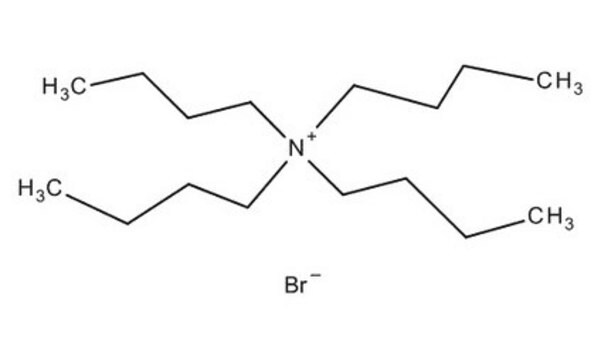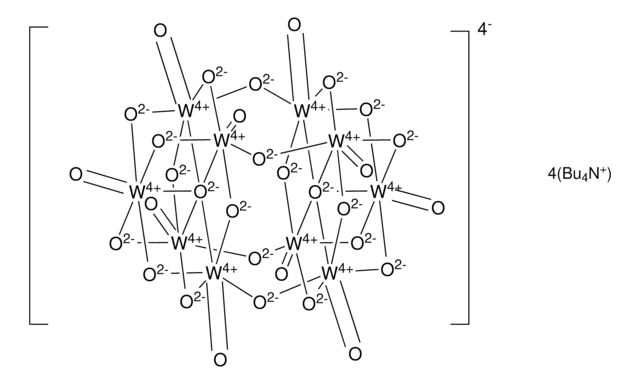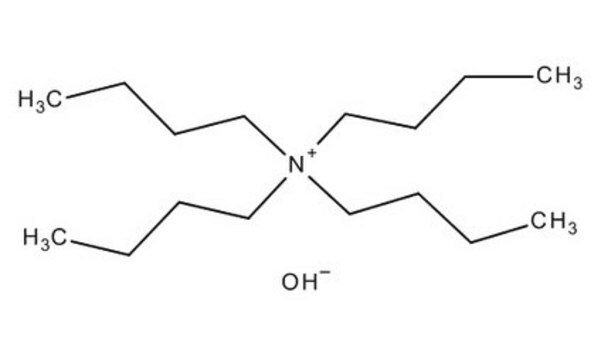8.18164
Tetra-n-butylammoniumfluorid-trihydrat
for synthesis
Synonym(e):
Tetra-n-butylammoniumfluorid-trihydrat, TBAF
About This Item
Empfohlene Produkte
Qualitätsniveau
Form
crystals
mp (Schmelzpunkt)
62-63 °C
Lagertemp.
2-30°C
InChI
1S/C16H36N.FH.3H2O/c1-5-9-13-17(14-10-6-2,15-11-7-3)16-12-8-4;;;;/h5-16H2,1-4H3;1H;3*1H2/q+1;;;;/p-1
InChIKey
VEPTXBCIDSFGBF-UHFFFAOYSA-M
Anwendung
- Unveiling the Use of 1,1-Bis(triflyl)ethylene as CF(3)SO(2)CH-CH(2) Source with the Assistance of (n-Bu)(4)NF.: This study discusses a synthetic approach using Tetra-n-butylammonium fluoride (TBAF) for generating 3-[(Trifluoromethyl)sulfonyl]cyclobut-1-enes, highlighting its role in mediating fluoride ion transfer in organic synthesis (Almendros et al., 2024).
- Speciation and kinetics of fluoride transfer from tetra-n-butylammonium difluorotriphenylsilicate (′TBAT′).: The article explores the speciation and kinetics involved in fluoride transfer processes using TBAT, a compound closely related to TBAF, providing insights into its utility in synthetic chemistry (Lloyd-Jones et al., 2024).
- Conjugated Polymers with Self-Immolative Sidechain Linkers for Carbon Nanotube Dispersion.: This research utilizes TBAF in the development of novel conjugated polymers with self-immolative sidechains for effective dispersion of carbon nanotubes, demonstrating its application in materials science and nanotechnology (Adronov et al., 2024).
- Room temperature synthesis of CdSe/CdS triangular nanoemitters and their stabilization in colloidal state and sol-gel glass.: The article discusses the synthesis of semiconductor nanostructures at room temperature, where TBAF plays a critical role in the stabilization of colloidal solutions (Parola et al., 2023).
Hinweis zur Analyse
Wasser (K. F.): 15,0–19,0 %
Signalwort
Warning
H-Sätze
Gefahreneinstufungen
Acute Tox. 4 Oral - Aquatic Chronic 3 - Eye Irrit. 2 - Skin Irrit. 2
Lagerklassenschlüssel
11 - Combustible Solids
WGK
WGK 3
Flammpunkt (°F)
Not applicable
Flammpunkt (°C)
Not applicable
Analysenzertifikate (COA)
Suchen Sie nach Analysenzertifikate (COA), indem Sie die Lot-/Chargennummer des Produkts eingeben. Lot- und Chargennummern sind auf dem Produktetikett hinter den Wörtern ‘Lot’ oder ‘Batch’ (Lot oder Charge) zu finden.
Besitzen Sie dieses Produkt bereits?
In der Dokumentenbibliothek finden Sie die Dokumentation zu den Produkten, die Sie kürzlich erworben haben.
Kunden haben sich ebenfalls angesehen
Unser Team von Wissenschaftlern verfügt über Erfahrung in allen Forschungsbereichen einschließlich Life Science, Materialwissenschaften, chemischer Synthese, Chromatographie, Analytik und vielen mehr..
Setzen Sie sich mit dem technischen Dienst in Verbindung.













